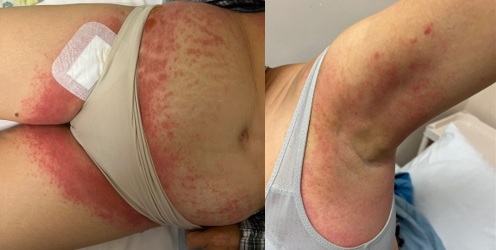Research & Publications > The Hong Kong Practitioner > Clinical Quiz

Clinical Quiz (Please login 'Member Area' for online submission of latest issue)
Clinical Quiz Mar 2022
A 55-year-old woman presented with acute onset
of flexural erythema occurring symmetrically
over both inguinal and axilla regions
Sze-man Wong, King-man Ho
|
Readers are invited to participate in the Clinical Quiz*. Simply answer the question, fill in the reply slip and return it to the College by 17 May 2022. Each reader is allowed to submit one entry only. The name of the winner and the answer will be published in the June 2022 issue.
*Note: There would be no prize award for this issue while sponsorship for Clinical Quiz has been ended in September 2020 issue. The answer of the Clinical Quiz for this issue will be announced in the next issue. Thank you for your support.
|
Clinical history:
A 55-year-old woman presented with acute onset of flexural erythema occurring
symmetrically over both inguinal and axilla regions. Blisters appeared along waist band
over lower abdominal wall. She denied of fever, constitutional symptoms, abdominal
pain, diarrhoea, vomiting nor angioedema. She is a known hepatitis B carrier with
normal liver function. She denied of medication use prior to onset of rash, except new
intake of preserved dried beans. The rash resolved spontaneously after 3-4 days.
What is the diagnosis?
| A. | Contact dermatitis |
| B. | Drug-related eosinophilia and systemic syndrome |
| C. | Symmetrical drug-related intertriginous flexural exanthema |
| D. | Inverse Psoriasis |
Answer:
C. Symmetrical drug-related intertriginous flexural exanthema
The patient likely suffered from Symmetrical drugrelated intertriginous flexural exanthema (SDRIFE). SDRIFE is a delayed type hypersensitivity reaction with classical cutaneous presentation of intertriginous (body folds) erythema of symmetrical pattern.
Criteria for SDRIFE include recent history of exposure to drug at first or repeated doses, erythema of the gluteal/perianal area and/or V-shaped erythema of the inguinal area, involvement of at least one other intertriginous localization, symmetry of affected areas, and absence of systemic toxicity. In severe form, blisters can be observed, but classically the mucosa is not involved and there is no systemic upset or organ involvement. The most common causes are aminopenicillins, β-lactam anti-bacterials, and certain chemotherapeutic agents and antiseptics such as thiomersal which is an antimicrobials used as preservatives including vaccine in the old days. In this patient, she denied new drug consumption nor traditional Chinese medication, except that she consumed preserved dried beans that may contain certain preservatives that prompt her to this condition. Patch test to test for any delayed sensitivity towards antibiotics, preservative or fragrances shall be considered. Food provoking test to verify if the symptoms are reproducible after exposure may also be done to confirm the diagnosis. Spontaneous resolution of rash is often observed after the culprit agent is stopped as in our case.
In Drug-related eosinophilia and systemic syndrome (DRESS), patient classically presents with fever and prodromal flu-like symptoms together with various form of rash such as maculopapular exanthem. Other diagnostic features include liver or renal impairment, raised eosinophil counts and atypical lymphocytes in the circulation are diagnostic criteria. DRESS is a delayed type of adverse drug reaction. Common drug involvement include antibiotics, anti-convulsants and allopurinol. Identification and discontinuation of the culprit drug is of ultimate importance. Systemic steroid with tapering dose shall be considered in case of systemic organ impairment. Our patient has no fever nor systemic upset. She remained well all along as well as having a normal blood count and organ functions.
Contact dermatitis (CD) can be broadly categorized into irritant and allergic types. The former type represent non-immune related skin reaction secondary to direct insult by the chemical/physical substance such as detergent. The allergic CD is a cutaneous hypersensitivity reaction to topical exposure of drug or metal/ chemical substance such as metal (nickel, cobalt), dye, fragrance, preservative, antibiotics. Clinically, it represents acute to subacute type eczema-like eruption over contact area. Avoidance is best strategy to prevent recurrence of CD. Our patient did not apply any topical agents prior to rash onset, so CD was not likely.
In flexural psoriasis or inverse psoriasis, skin lesions are found over intertriginous area with welldemarcated erythema, in contrast to psoriasis vulgaris with predominant extensor surface of limbs involved, with thick silvery scale. Nail pitting, onycholysis, salmon oil-drop discoloration over nails and scalp involvement can be observed. Family history of psoriasis and joint involvement are useful in making the clinical diagnosis. Treatments include topical corticosteroid and calcipotriols cream/ointment; in moderate-to-severe type of psoriasis, oral immunomodulatory drugs such as methotrexate, acitretin, cyclosporin and phototherapy shall be considered. Our patient has no other features of psoriasis nor personal/family history of psoriasis. And her rash spontaneously subsided after a few days.
In summary, SDRIFE should be strongly considered in a patient presenting with a symmetric intertriginous eruption involving multiple body folds. A detailed history and review of exposures will guide the clinician in the search for the most likely etiologic agent and exclude other potential diagnoses.
The slide and the question were prepared by:
Dr Sze-man Wong, MBBS, MRCP(UK), MSc(London), FHKCP, FHKAM
Associate Consultant,
Division of Dermatology, Department of Medicine, Queen Mary Hospital, Hong Kong SAR.
Dr King-man Ho, FRCP (Glasg, Edin), MRCP (UK), FHKCP, FHKAM (Medicine)
Consultant Dermatologist-in-Charge,
Social Hygiene Service, PHSB, CHP, DH
Back
